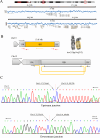Long read Nanopore sequencing identifies precise breakpoints of a de novo paracentric inversion that disrupt the MEIS2 gene in a Chinese girl with syndromic developmental delay
- PMID: 39789493
- PMCID: PMC11715414
- DOI: 10.1186/s12887-024-05267-z
Long read Nanopore sequencing identifies precise breakpoints of a de novo paracentric inversion that disrupt the MEIS2 gene in a Chinese girl with syndromic developmental delay
Abstract
Background: Chromosomal inversions are underappreciated causes of rare diseases given their detection, resolution, and clinical interpretation remain challenging. Heterozygous mutations in the MEIS2 gene cause an autosomal dominant syndrome characterized by intellectual disability, cleft palate, congenital heart defect, and facial dysmorphism at variable severity and penetrance.
Case presentation: Herein, we report a Chinese girl with intellectual disability, developmental delay, and congenital heart defect, in whom G-banded karyotype analysis identified a de novo paracentric inversion 46,XX, inv(15)(q15q26.1) and other conventional approaches including chromosomal microarray analysis and whole exome sequencing were failed to detect any pathologic variants that can explain the phenotypes of the proband. Subsequently, long-read Nanopore sequencing was directly conducted and defined the breakpoint position of the inversion, disrupting the MEIS2 gene at intron 8. These breakpoints were also confirmed by Sanger sequencing.
Conclusions: In conclusion, we report the first chromosomal inversion disrupting the MEIS2 gene, which was fine-mapped by long read Nanopore sequencing. Our data not only expand the clinical spectrum of MEIS2-caused syndromic developmental delay, but also illustrate the value of long-read sequencing in elucidating the precise genetic etiology of patients with relatively nonspecific clinical findings and chromosomal inversion that are beyond the resolution of conventional approaches.
Keywords: Long read sequencing; MEIS2; Paracentric inversion; Syndromic developmental delay.
© 2024. The Author(s).
Conflict of interest statement
Declarations. Ethics approval and consent to participate: The written informed consent for the study was obtained from the parents of the proband, and all procedures were reviewed and approved by the Institutional Review Board of Nanjing Women and Children’s Healthcare Hospital (No. [2021] KY-104). Consent for publication: The written informed consent for publication was obtained from the parents of the proband. Clinical trial number: Not applicable. Competing interests: The authors declare no competing interests.
Figures



Similar articles
-
Multi-omics analysis detail a submicroscopic inv(15)(q14q15) generating fusion transcripts and MEIS2 and NUSAP1 haploinsufficiency.Sci Rep. 2024 Dec 5;14(1):30343. doi: 10.1038/s41598-024-81507-7. Sci Rep. 2024. PMID: 39639090 Free PMC article.
-
De novo missense variants in MEIS2 recapitulate the microdeletion phenotype of cardiac and palate abnormalities, developmental delay, intellectual disability and dysmorphic features.Am J Med Genet A. 2018 Sep;176(9):1845-1851. doi: 10.1002/ajmg.a.40368. Epub 2018 Jul 28. Am J Med Genet A. 2018. PMID: 30055086
-
Heterozygous loss-of-function variants of MEIS2 cause a triad of palatal defects, congenital heart defects, and intellectual disability.Eur J Hum Genet. 2019 Feb;27(2):278-290. doi: 10.1038/s41431-018-0281-5. Epub 2018 Oct 5. Eur J Hum Genet. 2019. PMID: 30291340 Free PMC article.
-
De novo MEIS2 mutation causes syndromic developmental delay with persistent gastro-esophageal reflux.J Hum Genet. 2016 Sep;61(9):835-8. doi: 10.1038/jhg.2016.54. Epub 2016 May 26. J Hum Genet. 2016. PMID: 27225850 Review.
-
A Recurrent De Novo Terminal Duplication of 14q32 in Korean Siblings Associated with Developmental Delay and Intellectual Disability, Growth Retardation, Facial Dysmorphism, and Cerebral Infarction: A Case Report and Literature Review.Genes (Basel). 2021 Sep 7;12(9):1388. doi: 10.3390/genes12091388. Genes (Basel). 2021. PMID: 34573370 Free PMC article. Review.
References
-
- Kosuthova K, Solc R. Inversions on human chromosomes. Am J Med Genet A. 2023;191(3):672–83. - PubMed
-
- Vicente-Salvador D, Puig M, Gaya-Vidal M, Pacheco S, Giner-Delgado C, Noguera I, et al. Detailed analysis of inversions predicted between two human genomes: errors, real polymorphisms, and their origin and population distribution. Hum Mol Genet. 2017;26(3):567–81. - PubMed
Publication types
MeSH terms
Substances
Grants and funding
LinkOut - more resources
Full Text Sources
Medical

